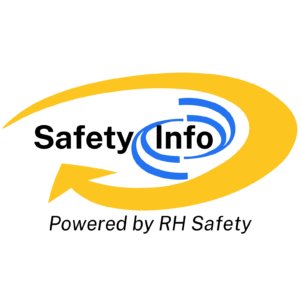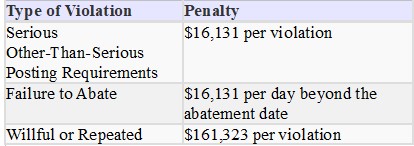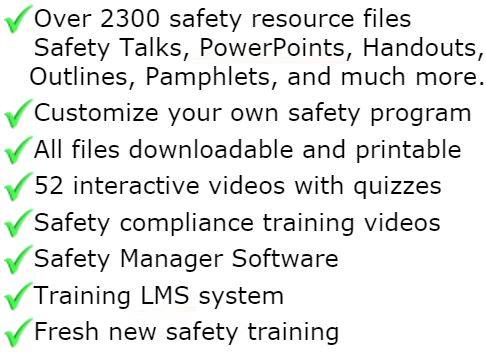
Workplace Safety Audit Guides
It is recommended that a team be established to conduct safety audit. Each team should be comprised of at least three to five people representing a variety of departments. To ensure neutrality and objectivity, it is suggested that team members should not audit their own department. Audits may also be conducted by qualified consultants. Audit Team members should review all existing safety program material in advance of the safety audit.
Safety Audits are conducted for the purpose of health, safety, and fire hazard identification. During these surveys, assessments are made for compliance to applicable regulations and fire codes as well as the detection of unsafe hazards.
Audits also provide an evaluation of workplace compliance to Occupational Safety and Health Administration (OSHA) standards relating workplace and worker safety.
Work Site Safety Audits
Audits of work sites are conducted for the purpose of health, safety, and fire hazard identification. During these surveys, assessments are made for compliance to applicable building and fire codes and the detection of unsafe hazards.
Work site audits also provide an evaluation of compliance to Occupational Safety and Health Administration (OSHA) standards relating to ergonomics, respirator use, hearing conservation, blood-borne pathogens and use of personal protective equipment. Ergonomics, the study of work and the relationships of carious stressors on the individual, can be identified through the building audits. The objective of ergonomics is to adapt the job and workplace to the worker by designing tasks, workstations, tools, and equipment to the abilities of the worker. Conducting a single annual comprehensive safety audit can actually hide the facts and hazards that you may want to discover. The single annual audit approach may tend to create a safety "ramp up" effect, by managers and supervisors, as the audit time approaches.
A better approach may be to schedule various specific safety audits throughout the year on a ten month schedule. The eleventh month should be reserved for a comprehensive annual audit. Consider using the same topic schedule for your annual refresher training program.
What safety audits are not
Safety Audits are primarily to check the effectiveness of the various programs, they do not take the place of regular facility inspections. Facility safety inspections for hazards and their control should be performed on a weekly basis by supervisors and on a monthly basis by management.
The big four
There are four basic questions a safety audit should answer. The persons or team designated to conduct the audits should take a fact finding approach to gather data. These auditors should be familiar with both the company program and the various local, state and federal requirements.
All safety audit comments, recommendations and corrective actions should focus on these four questions:
1. Does the program cover all regulatory and best industry practice requirements?
2. Are the program requirements being met?
3. Is there documented proof of compliance?
4. Is employee training effective – can and do they apply specific safe behaviors?
Phase One - Safety Audit Preparation
Step One - one week prior to the audit, inform all affected managers and supervisors. They should be directed to have all records, documents and procedures available when the audits starts.
Step Two - Review all past program area audits and corrective action recommendations.
Step Three - Review all company, local, state and federal requirements for the specific program. Become familiar with the document, inspection and training requirements.
Step Four - Determine the scope of the audit. This can be based on accident and inspection reports and input from various managers. Set a start and stop time & date for the audit.
Phase Two - Fact Finding
A fact finding event is used to gather all applicable information. Auditors should make an effort not to form an opinion or make evaluative comments during this phase.
A Team Approach - If a safety audit team is used, make assignments to each person that defines their area of inspection. Ensure they have the proper program background information and documents.
Safety Audit Areas - most audits can be broken down into these areas:
Employee knowledge – OSHA standards require "effective training" - an effective program ensures that employees have the knowledge required to operate in a safe manner on a daily basis. The level of knowledge required depends on the specific activities in which the employee is involved and their specific duties and responsibilities. Generally, managers and supervisors should have a higher level of knowledge than general employees. This includes practical knowledge of program administration, management and training. They should be able to discuss all elements of each program that affects their assigned employees. Many programs divide employees into these two groups- authorized employees and affected employees. Authorized employees must have a high level of working knowledge involving hazard identification and hazard control procedures. Determining employee level of knowledge can be achieved though written quizzes, formal interviews or informal questions in the workplace.
Written Program Review - during the safety audit, a comprehensive review of the written program should be conducted. This review should compare the company program to requirements for hazard identification and control, required employee training and record keeping against the local, state and federal requirements. Additionally, if applicable, the company insurance carrier should be asked to conduct an independent written program review.
Program Administration - This part of the safety audit review checks the implementation and management of specific program requirements. This section asks these and other similar questions:
• Is there a person assigned and trained to manage the program?
• Are specific duties and responsibilities assigned?
• Are sufficient assets provided?
• Is there an effective and on-going employee training program?
Record & Document Review - Missing or incomplete documents or records is a good indication that a program that is not working as designed. Records are the company's only means of proving that specific regulatory requirements have been met. Record review also includes a look at the results, recommendations and corrective actions from the last program audit.
Equipment and Material - This area of an safety audit inspects the material condition and applicability of the equipment for hazard control in a specific program. Examples of audit questions for this area are:
• Is the equipment in a safe condition?
• Is there adequate equipment to conduct tasks safely?
• Is personal protective equipment used and stored properly?
• Is equipment, such as exit lights, emergency lights, fire extinguishers, material storage and handling equipment designed and staged to control hazards effectively?
General Area Walk-Through - While safety audits are not designed to be comprehensive physical wall-to-wall facility inspections, a general walk-though of work areas can provide additional insight into the effectiveness of safety programs. Auditors should take written notes of unsafe conditions and unsafe acts observed during the walk-through.
Phase Three - Review of Findings of the safety audit
After all documents, written programs, procedures, work practices and equipment have been inspected, gather your team and material together to formulate a concise report that details all areas of the program. Remember to focus on the four basic questions mentioned earlier. Each program requirement should be addressed with deficiencies noted. Include comments of a positive nature for each element that is being effectively managed.
Phase Four - Recommendations from the safety audit
Develop recommended actions for each deficient condition of the program. Careful forethought should be applied to ensure that this is not a process that simply makes more rules, additional record keeping requirement or makes production tasks more difficult. Examine the manner and means in which the current deficient elements are managed to determine if there is a simpler procedure that can be employed.
Phase Five - Corrective Actions from the safety audit
Development of corrective action should involve the managers and supervisor who will be required to execute the corrections. Set priorities based on level of hazard. All corrective actions should be assigned a completion and review date. Records of completed corrective actions should be reviewed through the normal management chain and then be filed for use during the next audit.
Phase Six - Publish the Safety Audit results
It is essential to let all supervisors and manager know the basic findings and recommendations. Don’t forget to acknowledge those departments, managers and supervisors who are properly executing their responsibilities. After a few audits, everyone will want to show up on the plus side of the results, making the safety mangers job much easier..
All materials in the members area for this topic index

GET INSTANT ACCESS
to THE MEMBERS LIBRARY
Safety materials created by safety professionals.
Access to the Safety Manager software.
Wide variety of safety videos and courses.
**Brand New** Safety Training Management System
Pre-Made Safety Materials Ready For Use
Created by experienced safety professionals & risk consultants. Saving you time, money, and risk of injuries.
95% of the work already done.
Below are the maximum penalty amounts, with the annual adjustment for inflation, that may be assessed after Jan. 15, 2024. (See OSHA Memo, Jan. 8, 2024).

**New OSHA HEAT 90 DAY**
>>Download Free HERE<<
**New 2024 OSHA 300 Form**
>>Download Free HERE<<
**Brand New**
Free with full membership subscription
Training LMS System
Ask The Safety Consultant
Safety Equipment Deal Finder

“SafetyInfo.com is the first go-to website for safety professionals and companies to use in establishing a solid safety program"
-Mike McKenzie, Certified Safety & Health Manager (CSHM), McSafety Solutions™
Note: You must have a full subscription to the Safety Library in order to use this material. Any use outside of your organization, for resell, or without an active membership is strictly prohibited and may result in prosecution under copyright infringement laws. Please contact us first, if you would be interested in reselling or using our materials for reproduction.
Inside the Members Library
Topic Index
Accident Prevention
Air Quality
Asbestos
Bloodborne Pathogens
Boilers
Chemical Safety
Compressed Gas
Confined Space
Construction
Construction Worksite
Cranes & Slings
Driver / Fleet Safety
Drug Free Workplace
Electrical
Emergency Management
Engineering Safety
Environmental
Equipment
Ergonomics
Fall Protection
Fire Safety & Prevention
First Aid
Flammable Materials
Forklifts
Hazard Communication
Hazardous Materials
Hearing Protection
Heat Stress
Hot Work
Housekeeping
Job Safety Analysis
Laboratory
Ladders
Lead
Lockout-Tagout
Machinery & Equipment
Material Handling
MSDS (SDS)
Medical & First Aid
Occupational Health
Office Safety
Off the Job Safety
Personal Protection
Process Safety
Record Keeping
Respiratory Protection
Silica Safety
Rules & Policies
Signs & Labels
Slips, Trips & Fall
Training
Terrorism Programs
Tool Safety
Vehicle & Driver
Violence Programs
Welding & Hot Work
Training Videos
Library Index
Training Materials
Videos/Courses
Talks
Articles
PowerPoint
Handouts
Training Overheads
Quizzes
Supervisor Briefs
Management Briefs
Safety Sessions
2 Minute OSHA Safety Talks
Pamphlets
First Aid Training
Supervisor Training
Hazardous Materials
Bomb Threat
Crossword Puzzles
Biological Agents
Forms & Documents
Forms
Checklists
Audit Guides
Inspections Guides
Signs & Labels
Environmental Audit Guides
Recordkeeping - OSHA 300
Sign & Label Maker
Safety Management Resources
Safety Manuals/Written Programs
Ergonomic Programs
Emergency Plans
Process Safety Management
Construction Safety
Occupational Health
Environmental
Topic Sheets
DOT Fleet-Driver
Hazardous Materials
Chemical Safety
Drug Free Workplace
Terrorism Programs
Development Guides
Safety Manager Software
Safety References & Graphics
Technical Safety Information
Posters
Topic & Fact Sheets
Development Information
Job Specific Safety Rules
Terrorism
Calculators
Safety Comic Strips
New Safety Training System
Schedule and train your employees with our materials. Add unlimited amount of employees. Record all progress and issue certificates. For group and individual training sessions.

